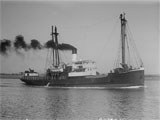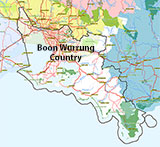Coramba
![]() Wreck Dive |
Wreck Dive | ![]() Boat access
Boat access
![]()
![]()
![]()
Twin Screw Steamer | Max Depth: 66 m (217 ft)
The Coramba (aka TSS Coramba) is socially and historically significant, as one of Victoria's worst shipwreck tragedies in living memory. Relatives of those who were lost are still alive, and the tragedy claimed the lives of fathers and breadwinners during the Depression. 17 lives were lost in the tragedy.
After 7 years of searching the TSS Coramba was discovered by Southern Ocean Exploration (SOE) on the 29th May 2011 approximately 10 nm (19 km) south of Seal Rocks, Victoria.
The shipwreck of the Coramba lies in a north-south direction, with the bow pointing towards the south. The vessel is lying on its port side, almost upside down.
TSS Coramba History — Built in 1911
The TSS Coramba was built in 1911, for the North Coast Steam Navigation Company by Ailsa Ship Building Co Ltd at Troon, Scotland and launched 15 August 1911. She was a 531 l-ton (540 t) displacement twin screw steamer that measured 160 ft (49 m) long, 30 ft (9.14 m) wide and 10 ft (3.05 m) deep.
The Coramba was owned by the Belfast and Koroit Steam Navigation Company. The vessel was purchased by them to replace the SS Casino which had been wrecked at Apollo Bay with major loss of life in 1932.
The Coramba served the Western District ports and had replaced the Casino which had also been tragically wrecked two years before. The wrecks of the Casino and Coramba were the death knell for steamship services to the Western District as railways and road transport replaced shipping for trade. 'The Coramba Gale' in which the Coramba foundered is still one of the worst storms recorded to have hit Victoria, with widespread flooding, wind damage and property loss in the south-eastern Melbourne metropolitan district.
Coramba Sinking — 30 November 1934
The Coramba left Warrnambool at 1 pm, on 29 November 1934 bound for Melbourne with a cargo of wool and Nestles Condensed Milk. It was due to arrive at about 7 am the following morning. Overnight the weather worsened and became a furious storm. The ship never arrived, and grave fears were held for its safety.
In early December, parts of the Coramba's deckhouse (identified by the vessel's bell) and other wreckage came ashore on the southern coast of Phillip Island along with a number of bodies. Well-known Victorian diver Johnno Johnstone was called in to locate the hull. Johnstone reported finding the hull in 27 fm (49 m) of water about 1.5 mi (2.41 km) west of Seal Rocks. However, attempts to relocate the vessel failed.
See also, Heritage Council Victoria: TSS Coramba,
Australian National Shipwreck Database: Coramba and
Southern Ocean Exploration: TSS Coramba.
Heritage Warning: Any shipwreck or shipwreck relic that is 75 years or older is protected by legislation. Other items of maritime heritage 75 years or older are also protected by legislation. Activities such as digging for bottles, coins or other artefacts that involve the disturbance of archaeological sites may be in breach of the legislation, and penalties may apply. The legislation requires the mandatory reporting to Heritage Victoria as soon as practicable of any archaeological site that is identified. See Maritime heritage. Anyone with information about looting or stolen artefacts should call Heritage Victoria on (03) 7022 6390, or send an email to [email protected].
Bass Strait Warning: Always keep an eye on sea conditions throughout any shore or boat dive in Bass Strait on Victoria's coastline. Please read the warnings on the web page diving-in-bass-strait before diving or snorkelling this site.
Traditional Owners — This dive site is in the traditional Country of the Boon Wurrung / Bunurong people of the Kulin Nation. This truly ancient Country includes parts of Port Phillip, from the Werribee River in the north-west, down to Wilson's Promontory in the south-east, including the Mornington Peninsula, French Island and Phillip Island, plus Western Port. We wish to acknowledge the Boon Wurrung as Traditional Owners. We pay respect to their Ancestors and their Elders, past, present and emerging. We acknowledge Bunjil the Creator Spirit of this beautiful land, who travels as an eagle, and Waarn, who protects the waterways and travels as a crow, and thank them for continuing to watch over this Country today and beyond.
Coramba Location Map
Latitude: 38° 32.116′ S (38.535267° S / 38° 32′ 6.96″ S)
Longitude: 145° 8.800′ E (145.146667° E / 145° 8′ 48″ E)
Datum: WGS84 |
Google Map
Added: 2012-07-22 09:00:00 GMT, Last updated: 2022-04-27 08:42:09 GMT
Source: GPS
Nearest Neighbour: Phelan Bluff, 2,284 m, bearing 6°, N
Twin Screw Steamer, 531 ton.
Built: Ayrshire, Scotland, 1911.
Launched: 15 August 1911.
Sunk: 30 November 1934.
Depth: 66 m.
[ Top ]
DISCLAIMER: No claim is made by The Scuba Doctor as to the accuracy of the dive site coordinates listed here. Should anyone decide to use these GPS marks to locate and dive on a site, they do so entirely at their own risk. Always verify against other sources.
The marks come from numerous sources including commercial operators, independent dive clubs, reference works, and active divers. Some are known to be accurate, while others may not be. Some GPS marks may even have come from maps using the AGD66 datum, and thus may need be converted to the WGS84 datum. To distinguish between the possible accuracy of the dive site marks, we've tried to give each mark a source of GPS, Google Earth, or unknown.




